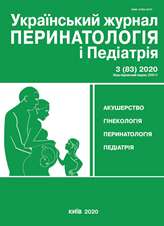Indicators of neonatal health of preterm infants
DOI:
https://doi.org/10.15574/PP.2020.83.40Keywords:
premature infants, morbidity, mortality, survival rateAbstract
Relevance. Monitoring of indicators of the health status of premature babies is one of the current scientific directions in neonatology.
Purpose — to determine the direction of long-term dynamics of indicators of neonatal health of premature babies in the Republic of Belarus.
Materials and methods. A retrospective analysis of epidemiological indicators for the period 2002–2018 was conducted on the basis of data from state statistical reports.
Results. The share of premature babies in the Republic of Belarus has stabilized at the level of 4.2–4.5%. The survival rate up to 1 year of infants with a body weight of 500–999 g increased by 2 times to the maximum level in 2018 (81.5%). Marked increase in General morbidity of prematurity for 2002–2010 (p<0.05) and reduction by 2016 (p=0.001), including those born weighing 500 to 999 g. more Often other diseases recorded are the syndrome of respiratory disorders, intrauterine hypoxia and birth asphyxia, increased frequency of infections specific to the perinatal period (p<0.05). The national premature mortality rate has stabilized at 0.95% over the past 9 years, with a 5-fold reduction in the rate among children with a body weight of 500—999 g.
Conclusions. The assessment of long-term dynamics of the main indicators of preterm health in the Republic of Belarus showed the effectiveness of implementing a set of organizational and medical measures, including the functioning of a multi-level system of perinatal care and the use of health-forming nursing technologies.
The research was carried out in accordance with the principles of the Helsinki Declaration. The study protocol was approved by the Local Ethics Committee of these Institutes. The informed consent of the patient was obtained for conducting the studies.
References
Ambalavanan N et al. (2012). Outcome trajectories in extremely preterm infants. Pediatrics. 130 (1): 115–125. https://doi.org/10.1542/peds.2011-3693d
Blencowe H, Cousens S, Oestergaard MZ et al. (2012, Jun 9). National, regional, and worldwide estimates of preterm birth rates in the year 2010 with time trends since 1990 for selected countries: a systematic analysis and implications. Lancet. 379 (9832): 2162–2172. https://doi.org/10.1016/S0140-6736(12)60820-4.
Dement'eva GM, Rjumina II, Frolova MI. (2004). Vyhazhivanie glubokonedonoshennyh detej: sovremennoe sostojanie problemy. Pediatrija. 3 (83): 60–66.
Euro-Peristat. (2013, May). European Perinatal Health Report. The health and care of pregnant women and babies in Europe in 2010. URL: https://www.tno.nl/media/1975/european-perinatal-health-report-2010.pdf.
Euro-Peristat. (2018, Nov). European Perinatal Health Report. Core indicators of the health and care of pregnant women and babies in Europe in 2015. URL: https://www.europeristat.com/images/EPHR2015_Euro-Peristat.pdf.
Martin JA, Hamilton BE, Osterman MJ et al. (2017, Jan). Births: Final Data for 2015. Natl Vital Stat Rep. 66 (1): 1.
Martin JA, Hamilton BE, Osterman MJ et al. (2018, Nov). Births: Final Data for 2017. Natl Vital Stat Rep. 67 (8): 1–50.
Medlock S et al. (2011). Prediction of mortality in very premature infants: a systematic review of prediction models. PLoS One. 6 (9): 234–241. https://doi.org/10.1371/journal.pone.0023441; PMid:21931598 PMCid:PMC3169543
Ministerstvo zdravoohranenija Respubliki Belarus'. (2010). Prikaz Ministerstva zdravoohranenija Respubliki Belarus' ot 23 janvarja 2010 goda No. 52. Ob utverzhdenii Polozhenija o raznourovnevoj sisteme perinatal'noj pomoshhi i porjadke ee funkcionirovanija v Respublike Belarus'. URL: https://mybiblioteka.su/ 6-63442.html.
Ministerstvo zdravoohraneniya Respubliki Belarus, Ministerstvo statistiki i analiza Respubliki Belarus. (1993). Prikaz-postanovlenie Ministerstva zdravoohraneniya Respubliki Belarus, Ministerstva statistiki i analiza Respubliki Belarus ot 09.11.1993 No. 254/75. O perehode na rekomendovannye Vsemirnoj organizaciej zdravoohranenija kriterii zhivorozhdenija i mertvorozhdenija. URL: http://www.levonevski.net/pravo/norm2013/num68/d68791.html.
Shalina RI, Vyhristjuk JuV, Krivonozhko SV. (2004). Perinatal'nye ishody u nedonoshennyh novorozhdennyh s jekstremal'no nizkoj i nizkoj massoj tela pri rozhdenii. Voprosy ginekologii, akusherstva i perinatologii. 3 (4):57-63.
Tielsch JM. (2015). Global Incidence of Preterm Birth. Nestle Nutr Inst Workshop Ser. 81: 9–15. https://doi.org/10.1159/000365798; PMid:26111559.
Tyson JE et al. (2008). Intensive care for extreme prematurity-moving beyond gestational age. N Engl J Med. 358 (6): 1672–1681. https://doi.org/10.1056/NEJMoa073059; PMid:18420500 PMCid:PMC2597069
Vinogradova IV, Krasnov MV, Nogteva LG. (2008). Katamnesticheskoe nabljudenie za det'mi s jekstremal'no nizkoj massoj tela pri rozhdenii. Prakticheskaja medicina. 31: 67–69.
Downloads
Published
Issue
Section
License
The policy of the Journal “Ukrainian Journal of Perinatology and Pediatrics” is compatible with the vast majority of funders' of open access and self-archiving policies. The journal provides immediate open access route being convinced that everyone – not only scientists - can benefit from research results, and publishes articles exclusively under open access distribution, with a Creative Commons Attribution-Noncommercial 4.0 international license(СС BY-NC).
Authors transfer the copyright to the Journal “MODERN PEDIATRICS. UKRAINE” when the manuscript is accepted for publication. Authors declare that this manuscript has not been published nor is under simultaneous consideration for publication elsewhere. After publication, the articles become freely available on-line to the public.
Readers have the right to use, distribute, and reproduce articles in any medium, provided the articles and the journal are properly cited.
The use of published materials for commercial purposes is strongly prohibited.

